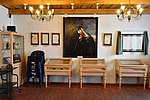Muzeum Adama Mickiewicza w Wilnie
 Muzeum - widok od podwórza | |
| Państwo | |
|---|---|
| Miejscowość | |
| Adres | Bernardinų g. 11, Vilnius, Lithuania |
Położenie na mapie Litwy (c) Karte: NordNordWest, Lizenz: Creative Commons by-sa-3.0 de | |
Muzeum Adama Mickiewicza w Wilnie (lit. Mickievičiaus Memorialinis Būtas-Muziejus) – muzeum mieszczące się w oficynie d. kamienicy Byczkowskich, w trzech pokojach. Zbiory obejmują liczne pamiątki z pobytów Mickiewicza w Wilnie i Kownie, m.in. portrety artysty, część jego księgozbioru, księgę rejestracyjną studentów z 1815 r., w której pod nr 93 figuruje Mickiewicz, jego prośby o urlopy, świadectwo ukończenia studiów i zeznania złożone w procesie filomatów. Znajdują się tu także przedmioty codziennego użytku, jak kapcie poety, krzesło czy stolik do gry w karty. W pomieszczeniach obecnego muzeum Mickiewicz robił korektę Ballad i romansów i dopracował Grażynę (upamiętnia to tablica Tu pisana Grażyna 1822) wmurowana wbrew carskim zakazom w 1855 r.[1]
Miejsce inauguracji dorocznego Międzynarodowego Festiwalu Poezji Maj nad Wilią[2].
Przypisy
- ↑ „Wilno. Przewodnik Pascala”, Jacek Podsiadło, Wydawnictwo Pascal, 2004. s. 63
- ↑ Nadchodzące wydarzenia kulturalne w Wilnie,, wilno.tvp.pl, 12 sierpnia 2022 [dostęp 2022-09-05].
Media użyte na tej stronie
(c) Karte: NordNordWest, Lizenz: Creative Commons by-sa-3.0 de
Location map of Lithuania
Autor: Scotch Mist, Licencja: CC BY-SA 4.0
Lithuania, officially the Republic of Lithuania, is a country in the Baltic region of Europe and is considered to be one of the Baltic states. It is situated along the southeastern shore of the Baltic Sea, to the east of Sweden and Denmark. It is bordered by Latvia to the north, Belarus to the east and south, Poland to the south, and Kaliningrad Region (a Russian enclave) to the southwest. Lithuania has an estimated population of 2.8 million people (as of 2019), and its capital and largest city is Vilnius. Other major cities are Kaunas and Klaipėda. Lithuanians are Baltic people.
For centuries, the southeastern shores of the Baltic Sea were inhabited by various Baltic tribes. In the 1230s, the Lithuanian lands were united by Mindaugas, the King of Lithuania, and the first unified Lithuanian state, the Kingdom of Lithuania, was created on 6 July 1253. During the 14th century, the Grand Duchy of Lithuania was the largest country in Europe; present-day Lithuania, Belarus, Ukraine, and parts of Poland and Russia were the territories of the Grand Duchy. With the Lublin Union of 1569, Lithuania and Poland formed a voluntary two-state ’personal union’, the Polish–Lithuanian Commonwealth. The Commonwealth lasted more than two centuries, until neighbouring countries systematically dismantled it from 1772 to 1795, with the Russian Empire annexing most of Lithuania's territory. As World War I (WWI) neared its end, Lithuania's Act of Independence was signed on 16 February 1918, declaring the founding of the modern Republic of Lithuania. In the midst of the Second World War (WWII), Lithuania was first occupied by the Soviet Union and then by Nazi Germany. As World War II neared its end and the Germans retreated, the Soviet Union reoccupied Lithuania. On 11 March 1990, a year before the formal Dissolution of the Soviet Union, Lithuania became the first Baltic state to declare itself independent, resulting in the restoration of an independent State of Lithuania.
Vilnius is in the southeast part of Lithuania and is the second largest city in the Baltic states. Vilnius is the seat of the main government institutions of Lithuania and the Vilnius District Municipality. Vilnius is known for the architecture in its Old Town, declared a UNESCO World Heritage Site in 1994. Before WWII, Vilnius was one of the largest Jewish centres in Europe. Its Jewish influence has led to it being described as the "Jerusalem of Lithuania" and Napoleon named it "the Jerusalem of the North” when he passed through in 1812. In 2009, Vilnius was the European Capital of Culture, together with the Austrian city of Linz. During the period of the Polish-Lithuanian Commonwealth, Vinlius underwent a period of expansion. The Vilnius city walls were built for protection between 1503 and 1522, comprising nine city gates and three towers, and Sigismund August moved his court there in 1544. Its growth was due in part to the establishment of Vilnius University by the Polish King and Grand Duke of Lithuania Stefan Batory in 1579. During its rapid development, the city was open to migrants from the territories of the Crown of the Kingdom of Poland, Grand Duchy and from further away. A variety of languages were spoken: Polish, German, Yiddish, Ruthenian, Lithuanian, Russian, Old Church Slavonic, Latin, Hebrew, and Turkic languages; the city was compared to Babylon. Each group made its unique contribution to the life of the city, and crafts, trade, and science prospered. The 17th century brought a number of setbacks. The Commonwealth was involved in a series of wars, collectively known as The Deluge. During the Russo-Polish War (1654–1667), Vilnius was occupied by Russian forces; it was pillaged and burned, and its population was massacred. During the Great Northern War it was looted by the Swedish army. Due to an outbreak of bubonic plague in 1710 and a succession of devastating fires the city's growth lost its momentum for many years, but even despite this fact, at the end of the 18th century and before the Napoleonic wars, Vilnius, entered the Russian Empire as its third largest city.
The Scotch Mist Gallery contains many photographs of historic buildings, monuments and memorials of Poland and countries that previously comprised the Polish-Lithuanian Commonwealth.
Autor: Scotch Mist, Licencja: CC BY-SA 4.0
Lithuania, officially the Republic of Lithuania, is a country in the Baltic region of Europe and is considered to be one of the Baltic states. It is situated along the southeastern shore of the Baltic Sea, to the east of Sweden and Denmark. It is bordered by Latvia to the north, Belarus to the east and south, Poland to the south, and Kaliningrad Region (a Russian enclave) to the southwest. Lithuania has an estimated population of 2.8 million people (as of 2019), and its capital and largest city is Vilnius. Other major cities are Kaunas and Klaipėda. Lithuanians are Baltic people.
For centuries, the southeastern shores of the Baltic Sea were inhabited by various Baltic tribes. In the 1230s, the Lithuanian lands were united by Mindaugas, the King of Lithuania, and the first unified Lithuanian state, the Kingdom of Lithuania, was created on 6 July 1253. During the 14th century, the Grand Duchy of Lithuania was the largest country in Europe; present-day Lithuania, Belarus, Ukraine, and parts of Poland and Russia were the territories of the Grand Duchy. With the Lublin Union of 1569, Lithuania and Poland formed a voluntary two-state ’personal union’, the Polish–Lithuanian Commonwealth. The Commonwealth lasted more than two centuries, until neighbouring countries systematically dismantled it from 1772 to 1795, with the Russian Empire annexing most of Lithuania's territory. As World War I (WWI) neared its end, Lithuania's Act of Independence was signed on 16 February 1918, declaring the founding of the modern Republic of Lithuania. In the midst of the Second World War (WWII), Lithuania was first occupied by the Soviet Union and then by Nazi Germany. As World War II neared its end and the Germans retreated, the Soviet Union reoccupied Lithuania. On 11 March 1990, a year before the formal Dissolution of the Soviet Union, Lithuania became the first Baltic state to declare itself independent, resulting in the restoration of an independent State of Lithuania.
Vilnius is in the southeast part of Lithuania and is the second largest city in the Baltic states. Vilnius is the seat of the main government institutions of Lithuania and the Vilnius District Municipality. Vilnius is known for the architecture in its Old Town, declared a UNESCO World Heritage Site in 1994. Before WWII, Vilnius was one of the largest Jewish centres in Europe. Its Jewish influence has led to it being described as the "Jerusalem of Lithuania" and Napoleon named it "the Jerusalem of the North” when he passed through in 1812. In 2009, Vilnius was the European Capital of Culture, together with the Austrian city of Linz. During the period of the Polish-Lithuanian Commonwealth, Vinlius underwent a period of expansion. The Vilnius city walls were built for protection between 1503 and 1522, comprising nine city gates and three towers, and Sigismund August moved his court there in 1544. Its growth was due in part to the establishment of Vilnius University by the Polish King and Grand Duke of Lithuania Stefan Batory in 1579. During its rapid development, the city was open to migrants from the territories of the Crown of the Kingdom of Poland, Grand Duchy and from further away. A variety of languages were spoken: Polish, German, Yiddish, Ruthenian, Lithuanian, Russian, Old Church Slavonic, Latin, Hebrew, and Turkic languages; the city was compared to Babylon. Each group made its unique contribution to the life of the city, and crafts, trade, and science prospered. The 17th century brought a number of setbacks. The Commonwealth was involved in a series of wars, collectively known as The Deluge. During the Russo-Polish War (1654–1667), Vilnius was occupied by Russian forces; it was pillaged and burned, and its population was massacred. During the Great Northern War it was looted by the Swedish army. Due to an outbreak of bubonic plague in 1710 and a succession of devastating fires the city's growth lost its momentum for many years, but even despite this fact, at the end of the 18th century and before the Napoleonic wars, Vilnius, entered the Russian Empire as its third largest city.
The Scotch Mist Gallery contains many photographs of historic buildings, monuments and memorials of Poland and countries that previously comprised the Polish-Lithuanian Commonwealth.
Coat of arms of Vilnius
Adam Mickiewicz Museum in Vilnius. Bernardinu g. 11
Logo of Vilnius
Autor: Walenty Wańkowicz , Licencja: CC BY-SA 4.0
Lithuania, officially the Republic of Lithuania, is a country in the Baltic region of Europe and is considered to be one of the Baltic states. It is situated along the southeastern shore of the Baltic Sea, to the east of Sweden and Denmark. It is bordered by Latvia to the north, Belarus to the east and south, Poland to the south, and Kaliningrad Region (a Russian enclave) to the southwest. Lithuania has an estimated population of 2.8 million people (as of 2019), and its capital and largest city is Vilnius. Other major cities are Kaunas and Klaipėda. Lithuanians are Baltic people.
For centuries, the southeastern shores of the Baltic Sea were inhabited by various Baltic tribes. In the 1230s, the Lithuanian lands were united by Mindaugas, the King of Lithuania, and the first unified Lithuanian state, the Kingdom of Lithuania, was created on 6 July 1253. During the 14th century, the Grand Duchy of Lithuania was the largest country in Europe; present-day Lithuania, Belarus, Ukraine, and parts of Poland and Russia were the territories of the Grand Duchy. With the Lublin Union of 1569, Lithuania and Poland formed a voluntary two-state ’personal union’, the Polish–Lithuanian Commonwealth. The Commonwealth lasted more than two centuries, until neighbouring countries systematically dismantled it from 1772 to 1795, with the Russian Empire annexing most of Lithuania's territory. As World War I (WWI) neared its end, Lithuania's Act of Independence was signed on 16 February 1918, declaring the founding of the modern Republic of Lithuania. In the midst of the Second World War (WWII), Lithuania was first occupied by the Soviet Union and then by Nazi Germany. As World War II neared its end and the Germans retreated, the Soviet Union reoccupied Lithuania. On 11 March 1990, a year before the formal Dissolution of the Soviet Union, Lithuania became the first Baltic state to declare itself independent, resulting in the restoration of an independent State of Lithuania.
Vilnius is in the southeast part of Lithuania and is the second largest city in the Baltic states. Vilnius is the seat of the main government institutions of Lithuania and the Vilnius District Municipality. Vilnius is known for the architecture in its Old Town, declared a UNESCO World Heritage Site in 1994. Before WWII, Vilnius was one of the largest Jewish centres in Europe. Its Jewish influence has led to it being described as the "Jerusalem of Lithuania" and Napoleon named it "the Jerusalem of the North” when he passed through in 1812. In 2009, Vilnius was the European Capital of Culture, together with the Austrian city of Linz. During the period of the Polish-Lithuanian Commonwealth, Vinlius underwent a period of expansion. The Vilnius city walls were built for protection between 1503 and 1522, comprising nine city gates and three towers, and Sigismund August moved his court there in 1544. Its growth was due in part to the establishment of Vilnius University by the Polish King and Grand Duke of Lithuania Stefan Batory in 1579. During its rapid development, the city was open to migrants from the territories of the Crown of the Kingdom of Poland, Grand Duchy and from further away. A variety of languages were spoken: Polish, German, Yiddish, Ruthenian, Lithuanian, Russian, Old Church Slavonic, Latin, Hebrew, and Turkic languages; the city was compared to Babylon. Each group made its unique contribution to the life of the city, and crafts, trade, and science prospered. The 17th century brought a number of setbacks. The Commonwealth was involved in a series of wars, collectively known as The Deluge. During the Russo-Polish War (1654–1667), Vilnius was occupied by Russian forces; it was pillaged and burned, and its population was massacred. During the Great Northern War it was looted by the Swedish army. Due to an outbreak of bubonic plague in 1710 and a succession of devastating fires the city's growth lost its momentum for many years, but even despite this fact, at the end of the 18th century and before the Napoleonic wars, Vilnius, entered the Russian Empire as its third largest city.
The Scotch Mist Gallery contains many photographs of historic buildings, monuments and memorials of Poland and countries that previously comprised the Polish-Lithuanian Commonwealth.















